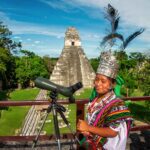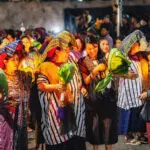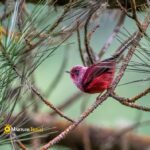Guatemala is undoubtedly one of the outstanding countries for vacationing in Central America, a multicolored destination where living culture, Mayan history, nature, colonial cities, and its culinary syncretism position it as the best of the region.
The enigmatic Mayan culture that still inhabits the highlands offers authentic experiences through unique religious syncretism. This syncretism is a mixture of the Catholic faith brought by the Spaniards and the Mayan beliefs that are present in the festivals and celebrations that natives develop during all year.
Here we present a description and dates of the main festivals of Guatemala, activities that you can easily include in your vacations, we are sure that will improve your experience in the Heart of the Mayan World.
Major Festivals in Guatemala
Festival of the Black Christ in Esquipulas – Jan 15th
The township of Esquipulas is located in southeastern regions of Guatemala close to the borders of El Salvador and Honduras. An attractive Baroque structure, which is painted in glossy white color, this basilica dominates the skyline of Esquipulas. Extraordinarily, this basilica has survived numerous earthquakes over many centuries with small damages.
Esquipulas Basilica is commonly known as Shrine of the Black Christ. As stated by Pope John Paul II, it is the “spiritual center of Central America.” This Basilica of Esquipulas every year attracts numerous pilgrims to the astounding statue of the Black Christ, which was carved in the year 1595
Several special processions, along with services, are organized on the Festival of the Black Christ, which takes place on 15 January and all through Holy Week every year. This basilica is completely jam-packed on these days with Guatemalan and Centro Americans pilgrims.
Festival of the Black Christ in the Island of Flores Peten
From Jan 6th to the 15th, The Island of Flores celebrates its Fiesta Patronal in honor of the Black Christ. The most popular dances that originate in this Fiesta Patronal are La Chatona and El Caballito, composed of monstrosities that simulate a giant woman and a horse. Both are accompanied by the marimba and are danced during the community´s patronal festivals.
Rabinal Patronal Fest on January 25th
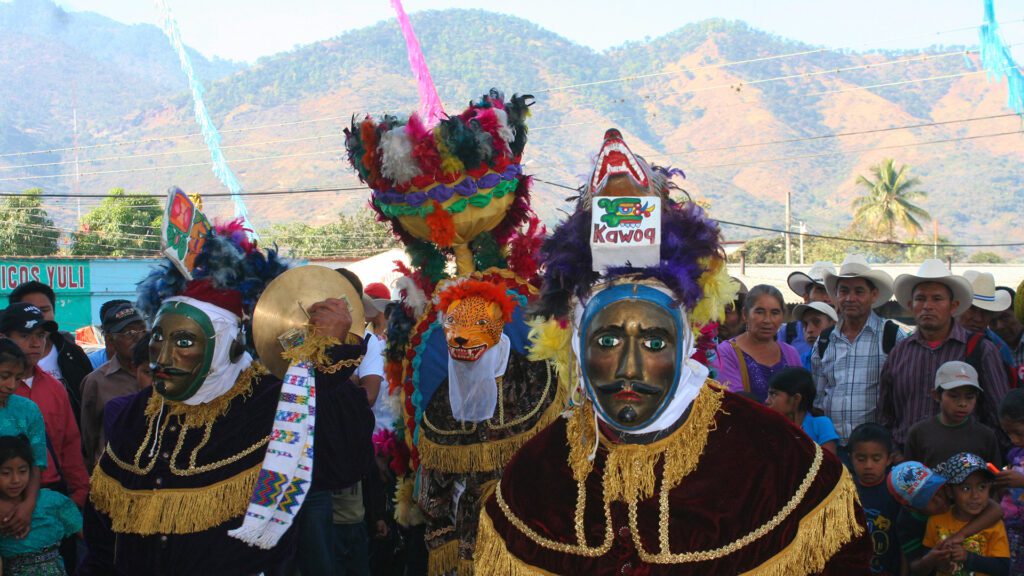
To the west of Salamá along a scenic road is the colonial town of Rabinal, famous for pottery and citrus harvest. Founded in 1537 by Fray Bartolomé de Las Casas, Rabinal adheres to many pre-Columbian traditions.
Every January 25th, Rabinal celebrates its Patronal fest in honor of Saint Pablo with huge expressions of folklore, with a magic mixture of indigenous, Spanish, and popular expressions of faith. There are several cofradías, groups of dancers, mostly indigenous, wearing masks and honoring Catholic saints.
Lent in Antigua Guatemala
This is the liturgical year leading up to Easter, this starts with Ash Wednesday and concludes on Holy Saturday. Every Friday of Lent there is a Holly Vigil in a Church in and around Antigua, The Holy Vigils generally take place at the church that will have the procession of the Christ and Virgin next Sunday. A brotherhood organizes the vigils, and there are different brotherhoods for each sculpture that will appear in the processions.
Holy Week in La Antigua Guatemala
During Holy Week, La Antigua Guatemala hosts one of the most amazing faith-based celebrations in Central America, when significant processions wind their way within the city’s avenues. The festival starts on Ashes Wednesday, the beginning of Lent, and gets to its climax on Good Friday when Antigua´s streets are thronged with processions and reverent spectator.
Everyone embellishes the streets with Easter week carpets making use of dyed sawdust, plants, fresh fruit, veggies, and various elements producing impressive designs for the procession to pass through. The marches incorporate large floats, or ‘andas,’ displaying sculptures of Jesus with a cross, which are transported by many purple-robed males.
A float with the Virgin Mary Follows by ladies wearing dark clothes. The processions proceed slowly. Antigua cobblestone avenues, the feet of the bearers cushioned inside the sawdust carpets that are damaged as the parade goes by.
Visiting Antigua while in lent and Holy Week usually means an exceptional spiritual fulfilling experience that you will always remember.
Jueves de la Ascención at La Laguna de Chicabal in Quetzaltenango
La Laguna Chicabal is a lime-green lake, at 2712 m, in the crater of the extinct volcano of the same name. The Mayas believed the waters are sacred, and it is thought that if you swim in the lake, you will get ill.
Ceremonies of Maya initiation are held at the lake in early May (40 days after Good Friday), known as Jueves de la Ascensión, and it’s celebrated with traditional music, flowers, and prayers at the Lake. Be respectful of the tradition, and you should not take pictures.
Corpus Christi
The Feast of Corpus Christi is a moveable feast, which means that it depends on the date of Easter Sunday. It is celebrated on the Thursday 50 days after Good Friday, in 2011, the Corpus Christi is on June 23rd, During the celebration of Corpus Christi, the town people create carpets made from grasses, flowers, and other plant materials. Following the mass, a procession of church leaders and walk through the streets of the town following the path provided by the carpets.
Solola, Antigua, and Flores are the places where this activity is held.
Palo Volador
Performers test out their abilities to the Palo Volador throughout the festivity of their Saint; incredibly extra tall pine poles are consecrated and set up within the plaza for that ceremony. Pole dancers climb up in pairs to the top level via platforms and ropes, and then they rotate at the end of the lines dizzyingly (and alarmingly) down in terrific swooping circles. The ceremony’s roots should lay inside the Maya traditions of Yaxche, the tree of life
The places where celebrates El Palo Volador are:
- July 25th in Cubulco Baja Verapaz
- Cubulco is located in Baja Verapaz 196 kms from Guatemala City (3 hours)
- August 15th in Joyabaj Quiche
- Joyabaj is located 216 kms from Guatemala City, about 70 kms away from Chichicastenango
- Dec 21st Chichicastenango
Santo Tomas is Chichicastenango’s patron saint, together with Christmas time coming to this festivity is among the year’s most significant events, probably equaled only by the Holy Week in La Antigua Guatemala. The celebration attracts an exceptionally massive audience throughout the highlands.
Festival of Rabin Ajau and election of Indian Princess Tesulután in Coban
July 25th
The celebrations that occur in the location of Cobán through the Folkloric Festival of the Rabin Ajau and also the election of the Princess Tesulutlán are the single most remarkable celebrations of indigenous traditions in Guatemala. The communities of Alta Verapaz are probably less popular with regards to tourism, and yet they are probably the most charming and rich in folklore.
In many of the villages in Alta Verapaz, particularly Cobán and San Pedro Carchá, the majority of the ancestral celebratory customs are conserved, especially the religious festivity of the Paabanc which is a unique traditional dance that is performed all over this area by the natives, the Kekchis, who express the perpetuation of their traditions and attires. Throughout this festivity, you’ll be able to discover and appreciate traditional meals and dances.
November 1st All Saints Day
November first is among the most important days of the year in Guatemala. During this day, we commemorate the Day of the Dead. This is a special event during which cemeteries are frequented and ornamented in reminiscence of family and friends. This is a union of ancient pagan beliefs, as well as the Catholic customs introduced over by the Spaniards within the XVI and XVII centuries.
During this time, two significant festivities occur “the horse races in Todos Santos Cuchumatan, Huehuetenango,” and also the giant kites in Santiago and Sumpango Sacatepéquez.
Giant Kites in Santiago & Sumpango Sacatepéquez
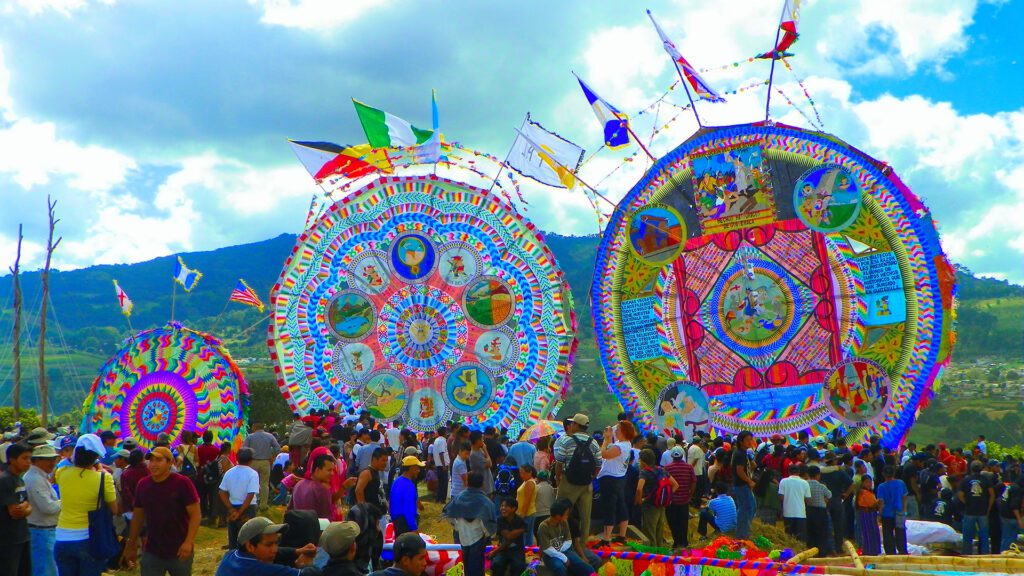
The towns of Santiago and Sumpango Sacatepéquez is of Cakchiquel origins, and it is found 30 Kilometers from La Antigua Guatemala. Through the morning hours, people within this village gather inside the narrow roads and start their procession towards the community cemetery. Then, they participate in the most vibrant traditions of Guatemala, flying gigantic kites to talk with their family and friends that have past away. The special event happens in the cemetery, and it finishes having a delicious meal as well as a traditional dish known as “fiambre.”
The Horse Race in Todos Santos Cuchumatanes Huehuetenango
The most popular event of the Todos Santos festival is the horse race. In the days previous the competition, the opponents celebrate, dancing, and ingest plenty of liquor. Additionally, they are attired with fancy clothes to make an impression of the spectator. The cause of the race dates back towards Spanish Conquest. The Spanish had not allowed the Mayas to ride horses. To show resistance to this particular rule, the people began this horse racing tradition.
The community inside the Cuchumatanes Mountains is of Mam origins, and the natives commemorate this day by racehorses and feeding on the most traditional recipes peculiar to that day. The older Indians reveal that the traditional food of the day starts with a prayer, after which black tamale is consumed.
24 Diablos Fest at Ciudad Vieja
December 7th and 8th
Every 7th of December, a parade or convite slowly makes its way through the streets of the former capital Ciudad Vieja just outside Antigua Guatemala. The following day they celebrate the town’s virgin patron’s day, Día de la Virgen de La Concepción, and after mass, in the cathedral, everyone crowds into the plaza outside for the noisy display of fireworks.


